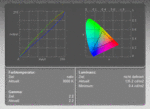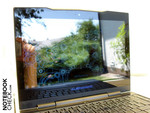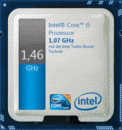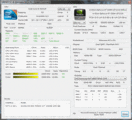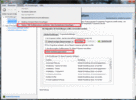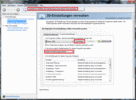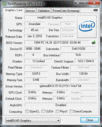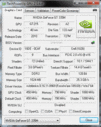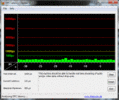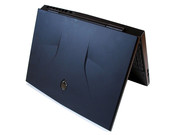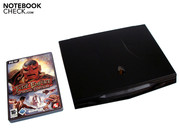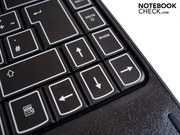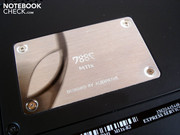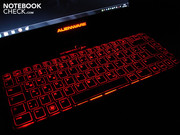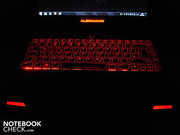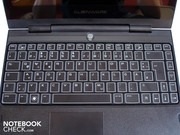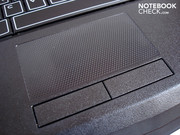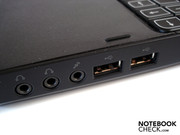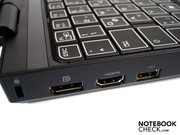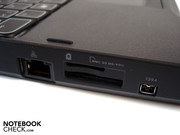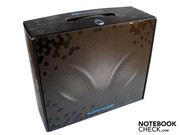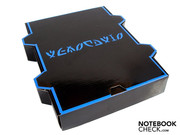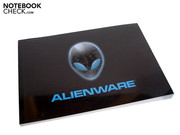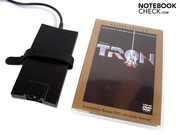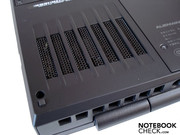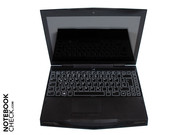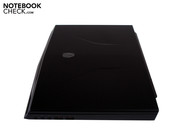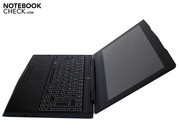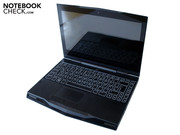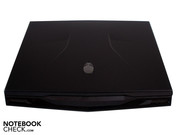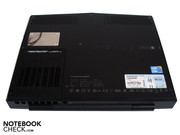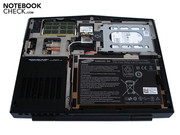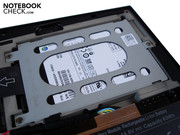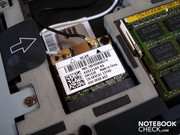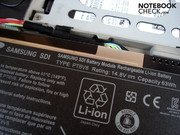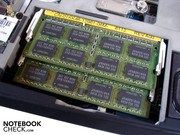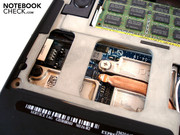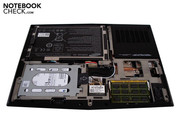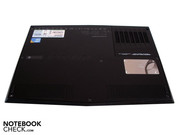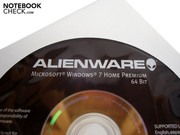Review Alienware M11x R2 Subnotebook
As usual for Alienware, the M11x R2 can be modified in various ways to suit individual needs. Starting with the color, where two alternatives are available with "Stealth Black" (black) and "Lunar Shadow" (silver). An energy saving processor from the latest Core iX range is used as the processor. It's then either the Core i5-520UM with 1.066 GHz and a 3MByte L3 cache or a Core i7-640UM with 1.20 GHz and a 4 MB L3 cache.
On the other hand, the RAM capacity ranges from two up to eight GB DDR3 RAM, whereas eight GB is disproportionally expensive with a surcharge of more than 400 euro. The buyer is spoilt for choice when it comes to the hard disk. He can choose between a HDD with a capacity of 250 to 500 GBs (7200 rpm) and a larger and significantly faster SSD of 256 GB, which has a steep surcharge of over 500 euro, though.
However, a WLAN module is integrated standardly, but Bluetooth costs extra. Because the M11x R2 doesn't have its own optical drive, Alienware offers an external drive for not quite 70 euro (8x DVD+/-RW). Aside from that, Windows 7 does its job as the operating system. The buyer only has to choose between the 64bit versions of Home Premium or Ultimate. Finally, the warranty period - depending on the wallet size - covers one to a maximum of four years. The buyer merely has no influence on the 11.6 inch display (1366x768) or on the graphic card. Alienware has opted for a midrange model from Nvidia with the GeForce GT 335M.
Our test model with a Core i5-520UM, a four GB DDR3 RAM, Windows 7 Home Premium, Bluetooth and a 256 GB SSD added up to a stately 1633 euro at the time of the test. If you don't need an SSD and, in return, opt for a 500 GB HDD, for example, you'll still end up at 1200 euro. But no matter which configuration you ultimately choose, a similar configuration of the first version is always considerably less expensive. We've examined if the additional costs of the M11 R2 are worth it.
Configuration and Supplies
Connectivity
Because there have been no modifications on the case, except for the connectivity, we've omitted a description of the categories case and input devices. In case of interest, please look at our first review about the Alienware M11x.
Basically, the M11 R2 provides the same interfaces as in the first review. Thus, there are two audio-outs, an audio-in and two USB 2.0 ports on the right. A cardreader and Firewire connection are on the left front. Additionally, the left again has a Kensington lock and a third USB 2.0 port. HDMI and display port have been placed further back in comparison to the predecessor. In return, the Fast Ethernet port (unfortunately) towards the front. The only significant difference: Alienware hasn't built in a VGA-out this time. All modern monitors have at least a DVI (with adapter compatible to HDMI), but nevertheless, this economy measure isn't quite intelligible.
Software and Supplies
The M11x can't quite keep up with the circumferential supplies (mouse pad, leather-bound manual & cap) of its bigger brothers, M15x and M17x. But the buyer gets more than the competition usually offers, anyway. Thus, a manual, a black and extremely soft velvet protection cover and an operating system DVD is found inside the elegantly designed carton, aside from the necessary 90 watt adapter. You fortunately don't have to trouble yourself with time consuming burning of recovery DVDs.
Alienware has retained itself pleasantly in terms of software. The system installation doesn't have any annoying bloatware. The so-called Command Center is the heart. The light elements can be adjusted (AlienFX), energy savings options modified (Alien Fusion), the touchpad configured (Alien Touch) and the security settings changed (Alien Sense) with assistance of a clearly arranged and easy to use interface.
Display
The mediocre display was one of the biggest critique points of the Alienware M11x. Unfortunately, hardly any improvements have been made in this regard. The brightness is still on a disappointingly low level with an average of 154.2 cd/m2. Games and movies noticeably lack brilliance. In return, the illumination has improved greatly from 80 to 92%. However, the user won't notice this much.
With 0.73 cd/m2, the black value presents itself slightly better in comparison to our first test device (0.81 cd/m2), which naturally could be due to production quality fluctuations, amongst other factors. A value of 0.73 cd/m2 is acceptable. Many notebooks are above 1.0 cd/m2. On the other hand, good displays have a black value of less than 0.4 cd/m2. The contrast is identical to the predecessor with a low 218:1. Finally, the colors made a good impression on us.
| |||||||||||||||||||||||||
Brightness Distribution: 92 %
Contrast: 218:1 (Black: 0.73 cd/m²)
The 11.6 inch display has a screen diagonal of 29.0 cm and a resolution of 1366x768 pixels. If you only have one window open, you'll be able to manage. But then, it quickly gets tight with two windows (e.g. office program and web browser) and comfortable working is only possible to an extent due to the limited room. Games and movies can't develop their full potential atmosphere because of the small display. It simply lacks the space to perceive all details accordingly. This condition gets especially noticeable in first person shooters, like Modern Warfare where battles are often carried out over large distances and opponents, respectively the crosshair look unpleasantly small.
A further flaw is the display's intense reflectiveness. You'll already frequently face disagreeable reflections indoors. First an extreme dimming of the room weakens this circumstance noticeably. The use outdoors, where a combination of annoying reflections and low display brightness hardly allow for seeing anything on the display, proves to be even more difficult. Thus, mobility is significantly restricted, despite its compact dimensions of 286 x 233 x 33 mm.
A picture similar to most screens currently built-in is shown in the viewing angles. Whilst the viewing angle stability is still okay on the horizontal plane, slight deviations on the vertical plane are already enough to falsify colors and illumination, and certain image areas quickly look gra
In summary, we would hope for an ultimately higher quality display in the next revision, which can also ideally be configured with an AR-coated surface.
Performance
Whilst a Pentium Dual Core SU4100 (1.30 GHz, 2 MB L2 cache), respectively a Core 2 Duo SU7300 (1.30 GHz, 3 MB L2 cache), still did its job in the first M11x, Alienware now uses two energy saving Core iX processors. The Core i7-640UM with 1.20 GH7 and a 4 MB L3 cache presents the spearhead. We've opted for the somewhat weaker Core i5-520UM. Like the faster Core i5 processors (e.g. the popular Core i5-430M), it has a 3 MB L3 cache.
The Core i5-520 doesn't have to hide from its kind in regards to its other features, either. Thus, the processor has the hyperthreading technology that provides a simulation of two additional CPU cores, which allows managing up to four cores simultaneously (primarily an advantage in optimized applications). Furthermore, the automatic overclocking function of Turbo Boost, which increases the clock rate from the standard 1.066 up to 1.866 GHz (sufficient cooling required), is onboard. The Pentium, respectively Core 2 processor, in the older model could also provide a maximum overclocking of 1.60 GHz, but Alienware did it manually.
The Core i5-520UM's power consumption isn't exactly low with 18 watts, but the memory controller and a graphic chip named GMA HD is integrated on the CPU. Downside: The Core i5-520UM can only address the RAM with a maximum of 800 MHz. Nevertheless, Alienware builds in a fast DDR3-10700 RAM with 1333 MHz.
Alienware sticks to its line and equips the M11x R2 again with a GeForce GT 335M. The midrange graphic card from Nvidia is manufactured in a modern 40nm process and can serve with 72 unified shaders and a 1024 MB sized DDR3 video memory. Unfortunately, the memory is only tethered to 128 bits, which can turn into a bottleneck in higher resolutions, respectively quality settings.
The GeForce GT 335M's clock rates are 450 MHz (core), 790 MHz (memory) and 1080 MHz (shader). Too bad: DirectX 11 support isn't available. The user has to be content with DirectX 10.1. In comparison to the ATI competition, the GeForce GT 335M places itself on par with the Radeon HD 4650/HD 4670. The Nvidia card doesn't reach the level of a Radeon HD 5650/HD 5730.
A highlight of the M11x is and will remain to be the switching between the integrated and dedicated graphics unit (GeForce GT 335M). However, the user doesn't have to intervene manually any more (switchable graphics). It's done fully automatically by Nvidia's exclusive Optimus Technology instead. The lightning fast, and for the user invisible, automatic switching process, which theoretically selects the suitable graphics unit at the start of an application, would primarily be named as an advantage of Optimus (the display would turn black for a few seconds with switchable graphics).
But exactly that is sometimes a problem in practical use. Optimus occasionally selects the wrong graphics and, for example, runs a graphic-biased application with the integrated graphic unit instead of the dedicated one (this was the case in Furmark and Metro 2033 in our test device). As a result, it's necessary to intervene manually (see right screenshot above), which takes the time that you should actually be saving with Optimus. Nvidia has to be given credit that the error rate has decreased considerably with the last drivers, though.
If you ultimately prefer switchable graphics or rather like Optimus is very dependent on individual taste. In any case, both alternatives have their benefits and drawbacks.
CPU Performance
In Cinebench R10 64bit's single-core rendering, the Core i5-520M (M11x R2) can distinguish itself, due to the somewhat higher clock rate (Turbo Boost) and its more efficient architecture, by a whole 20% with 2263 points from the Core 2 Duo SU7300 M11x R1), which only achieves 1880 points. Hyperthreading supplies a regular performance boost in multi-core rendering, because all cores are fully loaded. However the turbo mode revolts so that the Core i5-520UM only leads by 10% with 3946 in front of the Core 2 Duo SU7300 (3602 points), whose overclocking is always active.
By the way, both processors don't stand a chance against the currently fastest dual-core Core i7-620M (Asus N82JV). It computes twice as fast with 4295 points in single-core and 8962 points in multi-core rendering. In the CPU score of 3DMark06, the Core i5-520UM and Core 2 Duo SU7300 are closing in on each other strongly with 1402 to 1427 points. The Core i7-620M again plays in another league with 2943 points.
| PCMark Vantage Result | 5457 points | |
Help | ||
GPU Performance
First an important note before we dedicate ourselves to the graphic-biased benchmarks: Our test device crashed in several applications and games (3DMark Vantage, Need for Speed Shift & Risen) with an error report concerning PhysX. An installation of the latest PhysX software didn't help in this case, either. Upon inquiry at Nvidia, all applications worked perfectly after we replaced the pre-installed graphics driver 189.69 with the beta driver 257.30 from Dell's website.
We also compared the Alienware M11x R2 with its predecessor in the graphic benchmarks. A very big surprise followed right away in 3DMark03, where the Core 2 SU7300 placed itself in front of the Core i5-520UM (15146 points) by a remarkable 20% with 18130 points. The tide turned in 3DMark06 and the Core i5-520UM could assert itself by a tight 5% with 10299 points in front of the Core 2 Duo SU7300 (9798 points). Once again, a reversed picture was given by 3DMark06. The Core 2 Duo SU7300 calculated about 8% faster with 6462 than the Core i5-520UM (5958 points). In return, the Core i5-520UM took the lead in 3DMark Vantage and exceeded the Core 2 Duo SU7300 (2697 points) by 5% with 2845 points.
| 3DMark 03 Standard | 15146 points | |
| 3DMark 05 Standard | 10299 points | |
| 3DMark 06 Standard Score | 5958 points | |
| 3DMark Vantage P Result | 2845 points | |
Help | ||
SSD Performance
We determined the 256 GB sized SSD's (Samsung PM800 2) performance with CrystalDiskMark and AS SSD benchmark. Both tools certify that the hard disk has a good performance. Both the sequential read rate of 199 - 203 MB/s and the sequential write rate of 130 - 164 MB/s are noticeably superior to a conventional HDD. The SSD is proportionally slow only with smaller files and ranks itself far behind Intel's X25-M G2 (e.g. in mySN MG7.c).
Performance Verdict
We would describe the overall application performance as good. The Alienware M11x R2 masters common application scenarios, like video rendering or internet surfing perfectly. The relatively weak processor first comes to its limits in more demanding games and the wish for a few 100 MHz more of clock rate comes up.
In the following, the M11x R2 (Core i5-520UM) had to face both the first version, M11x (Core 2 Duo SU7300), as well as the Asus N82JV (Core i7-620M). We aimed to find out if the processor has a significant impact on the gaming performance or if it is always the graphic card that represents the limiting factor.
F.E.A.R. 2
The second part of the horror series principally ran fairly smooth with 36.9 fps even in very high details and 4x AA (1280 x 1024). Unfortunately, the frame rate plummeted in irregular intervals so that occasional, hefty stutters turned up. The GeForce 335M is just as fast as the Core 2 Duo SU7300 (36.8 fps), whereas the Nvidia card reached 39.6 fps with Core i7-620M. The M11x R2 (47.2 fps) and the M11x (46.9 fps) are very close in medium details and 2x AA (1024x768), the Asus N83JV runs away by 33% with 62.6 fps.
| F.E.A.R. 2 | |||
| Resolution | Settings | Value | |
| 1280x1024 | high, all on, 4xAA, biliniarAF | 36.9 fps | |
| 1024x768 | medium, all on, 2xAA, biliniarAF | 47.2 fps | |
Modern Warfare 2
The spectacularly staged shooter can only be enjoyed with restrictions due to 30.9 fps in high details and 4x AA (1366x768). Modern Warfare 2 feels smoother with both Core 2 Duo SU7300 (34.7 fps) and Core i7-620M (35.6 fps). The M11x R2 again falls behind its predecessor, M11x (38.6 fps), and the Asus N82JV (42.0 fps) with 36.0 fps.
| CoD Modern Warfare 2 | |||
| Resolution | Settings | Value | |
| 1366x768 | all on/high vsync off, high textures, 4xAA | 30.9 fps | |
| 1024x768 | all on/med vsync off, normal textures, 2xAA | 36 fps | |
Anno 1404
Very high details and 4x AF (1280x1024) overtax the combination of Core i5-520UM and GeForce GT 335M beyond duty. A meager 23.5 fps aren't enough for an optimal gaming experience. The GeForce GT 335M has just a hard time. In combination with a Core i7-620M and can only distinguish itself slightly with 24.8 fps. The graphic card's influence decreases noticeably in low details and disabled quality enhancements (1024x768). Because Anno 1404 scales massively with the number of cores and clock rate, major differences between the processors become evident. The Asus N82JV places itself far above the M11x R2 (57.8 fps) and the M11x (51.7 fps) with 107.8 fps.
| Anno 1404 | |||
| Resolution | Settings | Value | |
| 1280x1024 | very high, 0AA, 4AF | 23.5 fps | |
| 1024x768 | low, 0AA, 0AF | 57.8 fps | |
Bad Company 2
The latest offshoot of the popular Battlefield series counts to the more demanding tracks in terms of hardware. The Alienware M11x R2 is hopelessly overtaxed in high details and 4x AF (1366x768) - 24.3 fps speaks for itself. A smooth game play can't be considered on the Asus N82JV, either. The Alienware M11x R2 finds medium details and a waiver on quality enhancement (1024x768) more palatable (32.4 fps), whereas the Asus N82JV conjures the battles even smoother on the screen (35.4 fps).
| Battlefield: Bad Company 2 | |||
| Resolution | Settings | Value | |
| 1366x768 | high, HBAO on, 1xAA, 4xAF | 24.3 fps | |
| 1366x768 | medium, HBAO off, 1xAA, 1xAF | 32.4 fps | |
Shift
We made an unusual experience with the youngest offshoot of the Need for Speed series. Thus, medium details and 2x AA (1024x768) ran exactly 6 fps slower than high details and 4x AA (1366x768). Perhaps it was a window mode that Shift forcefully activates in certain resolutions? 29.5 fps in high details are enough in any event to race over the circuit. In comparison: The GeForce GT 335M's performance increases slightly to 30.2 fps with Core 2 Duo SU7300.
| Need for Speed Shift | |||
| Resolution | Settings | Value | |
| 1366x768 | all on/high, 4xAA, triliniarAF | 29.5 fps | |
| 1024x768 | all on/med, 2xAA, triliniarAF | 23.5 fps | |
Risen
High details and 4x AF (1366x768) stutter unplayable with the GeForce GT 335M, no matter if a Core 2 Duo SU7300 (21.2 fps), a Core i5-520UM (21.2 fps) or a Core i7-620M (23.2 fps) is inside the notebook. In return, the GeForce GT 335M finds medium details and 2x AF (1024x768) rather more agreeable, as can be seen on the example of the Asus N82JV, which can claim 33.6 fps for itself. M11x (29.4 fps) and M11x R2 (29.0 fps) follow at a slight distance.
| Risen | |||
| Resolution | Settings | Value | |
| 1366x768 | all on/high, 4xAF | 21.2 fps | |
| 1024x768 | all on/med, 2xAF | 29 fps | |
Dirt 2
If you don't expect much from the frame rate, you can try Dirt 2 even in high details and 2x AA. For example, we determined 26.8 fps in the native resolution of 1366x768. However, the Alienware M11x R2 is noticeably slower than the first version that achieved 33.1 fps in our last test. The lead shrinks in medium details and a resolution of 1024x768 and the M11x R2 can almost catch up with 32.4 to 34.8 fps. But both notebooks pull the short straw against the Asus N82JV's 49.2 fps.
| Colin McRae: DIRT 2 | |||
| Resolution | Settings | Value | |
| 1360x768 | High Preset, 2xAA | 26.8 fps | |
| 1024x768 | Medium Preset, 0xAA | 32.4 fps | |
Crysis
Lastly, we checked the performance with the undisputed graphics reference, Crysis and experienced a surprise. Whilst the "old" M11x still knows how to display medium details and a resolution of 1024x768 fairly smooth (34.8 fps), the successor, M11x R2, settles on the ridge of playability. In the meantime, the Asus N83JV can only smile wearily about both Alienwares with 43.8 fps. However, the Asus N82JV's fun also ends quickly. 25.2 fps are even too little for hardcore gamers. We don't have to mention the M11x (22.7 fps) and M11x R2 (22.5 fps), on which Crysis stutters even more.
| Crysis - GPU Benchmark | |||
| Resolution | Settings | Value | |
| 1024x768 | High | 22.5 fps | |
| 1024x768 | Medium, 0xAA, 0xAF | 28 fps | |
Gaming Performance Verdict
Several conclusions can be made after our detailed gaming tests. First: The CPU impact in low or medium details can be quite remarkable, but it's only conditionally relevant in high details - no matter if an energy saving starter processor (e.g. Core i5-520UM) or a high clocked, high-end bolide (e.g. Core i7-620M) built into a notebook is used with a midrange graphic card, like the GeForce GT 335M.
Secondly: The Alienware M11x refresh can hardly ever set itself apart from the first version. In opposition to the application benchmarks, the Core i5-520UM frequently computes even noticeably slower than the older Core 2 Duo SU7300. The reason is to be looked for especially in the low clock rate. Whilst the SU7300 is permanently overclocked to 1.60 GHz, the i5-520UM's turbo mode is often disabled so that the Alienware M11x R2 has to manage with only 1.066 GHz. Nevertheless, the given gaming performance is overall more than good and just outstanding for a subnotebook.
If you value a modern CPU architecture and want to at least reach the performance level of the first version in games at the same time, you should reconsider the surcharge for a Core i7-640UM, as it can serve with 1.20 GHz in any event. If you dare, you can also try yourself on a manual overclocking, which Alienware makes possible via bios (advanced / CPU Over-Clock). This way, the bus speed can be increased from 134 up to 166 MHz in one MHz steps.
| low | med. | high | ultra | |
|---|---|---|---|---|
| Crysis - GPU Benchmark (2007) | 28 | 22.5 | ||
| Crysis - CPU Benchmark (2007) | 26.9 | 21.3 | ||
| F.E.A.R. 2 (2009) | 47.2 | 36.9 | ||
| Anno 1404 (2009) | 57.8 | 23.5 | ||
| Colin McRae: DIRT 2 (2009) | 32.4 | 26.8 | ||
| Need for Speed Shift (2009) | 23.5 | 29.5 | ||
| Risen (2009) | 29 | 21.2 | ||
| CoD Modern Warfare 2 (2009) | 36 | 30.9 | ||
| Battlefield: Bad Company 2 (2010) | 32.4 | 24.3 | ||
| Metro 2033 (2010) | 29.1 | 24 |
Emissions
System Noise
The second version of the M11x makes a noticeable step forward in noise development. The case's small fan is only slightly audible in 2D mode (office, internet, movies, etc.). The fan even deactivates itself completely in low load so that the notebook is almost silent. The noise level increases to a well audible, but not yet disturbing, level in 3D mode (benchmarks, games, etc.). The gaming sounds are usually not drowned out. The M11x R2 first attracts attention under full load with a very audible, and in the long run, annoying noise.
Talking about annoying: As we unfortunately could observe in more and more test devices lately, the M11x R2's adapter partly emits a quiet whine, which is why the adapter should be stowed as far as possible under the desk. A minor whistling could also be heard from the notebook, in the area of the fan, when listening closer. Because everyone has a slightly different noise sensitivity, such interferences can annoy some users, whereas others shouldn't have any problems with it. Nevertheless, we found the noise development better than in the first M11x, which proved to be more present especially under load.
Noise Level
| Idle |
| 31.7 / 31.7 / 31.7 dB(A) |
| HDD |
| 31.9 dB(A) |
| Load |
| 34.2 / 43.4 dB(A) |
 | ||
30 dB silent 40 dB(A) audible 50 dB(A) loud |
||
min: | ||
Temperature
The reverse side of the lower noise emissions is the increased temperatures. The M11x R2 isn't exactly cool in idle mode with partly 41.1°C on the bottom and 36.6°C on the upper side. The surfaces heat up extremely under load. A use on the lap gets unpleasant due to the base's temperature of up to 46.7°C. The situation isn't much better on the upper side. The gaming fun is spoilt considerably by a maximum of 44.3°C in the WASD key area and a maximum of 41.2°C on the left wrist-rest area. You inevitably get the feeling, you're placing your palms on a heating.
Now we look at the components that always presented themselves as acceptably tempered. When the M11x R2 isn't put under load, the processor and graphic card settle at about 50°C. Under full load (Furmark + Prime), the Core i5-520UM's temperature increases up to 73°C, which is about on par with the Core 2 Duo SU7300 in the predecessor (max. 71°C). In return, there are bigger differences in the graphic card. Whilst the GeForce GT 335M didn't heat up to more than 68°C in the first M11x, it's a whole 15°C more in the M11x R2 (max. 83°C).
(±) The maximum temperature on the upper side is 44.3 °C / 112 F, compared to the average of 35.9 °C / 97 F, ranging from 21.4 to 59 °C for the class Subnotebook.
(-) The bottom heats up to a maximum of 46.7 °C / 116 F, compared to the average of 39.3 °C / 103 F
(±) In idle usage, the average temperature for the upper side is 34.5 °C / 94 F, compared to the device average of 30.8 °C / 87 F.
(-) The palmrests and touchpad can get very hot to the touch with a maximum of 41.2 °C / 106.2 F.
(-) The average temperature of the palmrest area of similar devices was 28.2 °C / 82.8 F (-13 °C / -23.4 F).
Loudspeakers
The sound of both loudspeakers placed on the case's bottom surprised us positively. Of course, the quality level of an external sound system can't be reached in any way, but the sound is above average good for a 11.6 inch subnotebook and doesn't have to hide even from a typical 15 inch notebook. The slightly imprecise and muffled sound would be mentioned as weaknesses. It lacks dynamics and volume. In order to tickle the most out of the integrated sound system, you should really check if instant mode is enabled under improvements in the loudspeaker properties. We additionally recommend the use of SRS Premium Sound Technology. The sound can be additionally optimized with assistance of three scenarios (movie, music & games).
Battery Life
Alienware equips the M11x R2 with a fixed eight cell battery (63 Wh), which provides for very good runtimes in interaction with Optimus Technology. In order to determine the minimum runtime, we executed BatteryEater's Classic test with maximum brightness and disabled energy savings options. The M11x R2, which can also serve with a 63 Wh battery, positions itself slightly in front of the Asus N83JV (1.5 hours) with one hour and 42 minutes,
Because the M11x R2 doesn't have an optical drive, we were forced to run the obligatory movie test with an avi video file. The subnotebook was exhausted after exactly four hours with maximum brightness and medium energy savings options. That's about 20 minutes less than the M11x with a Core 2 Duo SU7300 CPU. The difference increases in internet surfing and the M11x R2 lags behind its colleague by about an hour with 4.5 to 5.5 hours. Finally, a runtime of up to six hours is possible with minimum brightness and maximum energy savings options when the M11x R2 isn't put under much load (BatteryEater's Reader's test) (M11x: 7.5 hours).
All runtimes were measured with the integrated GMA HD graphic unit, except for the load test. With exception of the idle test, the case illumination was turned on.
UPDATE: Alienware has released a new version of the Command Center (2.5.54.0, A7) in the meantime, which is supposed to increase the battery life amongst other things. We didn't have to be told twice and executed the BatteryEater's Reader's test a second time. Result: The runtime increased by a remarkable 34 minutes from previously 6 hours and 2 minutes to now 6 hours and 36 minutes. To check if your M11x R2 is up-to-date, you should open the Command Center and click on updates in the bottom right.
The energy requirement doesn't show any irregularities. 13.6 - 20.1 in idle mode (GMA HD) and 50.2 - 53.0 watts under load (GeForce GT 335M) aren't in anyway low for a 11.6 inch device, but in view of the given performance acceptable.
| Off / Standby | |
| Idle | |
| Load |
|
Key:
min: | |
Verdict
To our regret, Alienware stagnates with its M11x R2. Thus, the noise emissions have improved, but in return, the temperature development has increased. The user is faced with a similar dilemma in performance. On the one hand, current Core iX processors can score with a higher application performance due to cutting-edge features, like Turbo Boost and hyperthreading. On the other hand, the Core i5-520UM's gaming performance has slightly decreased in comparison to the (overclocked) Core 2 Duo SU7300.
Alienware still hasn't dealt with the largest complaint: The 11.6 inch display still disappoints with a meager brightness and an average contrast, and the massive reflectiveness unnecessarily limits mobility. Because Alienware estimates at least 1000 euro for the new edition, the value for money ratio also suffers. The additional value in face of the less expensive model is simply too small to justify this surcharge.
But enough of harsh words, because the M11x R2's numerous strengths should not remain unmentioned. Starting with the elegant case, which can set itself apart from the competitors in terms of quality if nothing else, with its chic lighting elements and the high-end workmanship. Continuing over the good battery runtimes that make sufficiently long trips remote from a power supply. Finally, Nvidia's promising Optimus Technology ensures the almost perfect compromise of power consumption and performance.
Overall: If you're looking for a small as possible notebook with as much performance as possible, the Alienware M11x R2 is just right. The little power mite simply has an unrivalled speed for its size.











